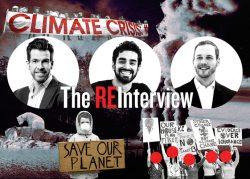This year, real estate awoke to its status as the quiet villain of climate change.
The horrifying stats — the industry is responsible for 30 percent of greenhouse gas emissions and 40 percent of energy use — echoed in more and more quarters, decarbonization became part of the rhetoric at major firms, and an entire day of the United Nations climate change conference was set aside to the built environment.
Amid the heightened awareness, “ESG” supplanted “OPM” as the industry’s pet acronym.
Short for “environmental, social, and governance,” it became a way to telegraph Earth-friendly efforts to operate, develop and invest. On Monday, PERE, a trade publication for real estate investors and fund managers, declared on the cover of its special ESG issue that “real estate’s race to net zero is picking up pace.”
The issue features insights from ESG chiefs at the world’s leading real estate managers and investors.
“ESG presents itself as a driver of change, both internally and externally,” said Invesco’s Maximilian Kufer.
“You’ll be hard-pressed to find any firm today that doesn’t have an ESG target or is not planning to implement one soon,” added Hines’ Peter Epping.
And Ivanhoé Cambridge’s Stéphane Villemain noted that “when a tenant comes into town and looks for a space to rent, it’s likely to favor one with the highest ESG rating.”
To make real progress on climate change, you need to know where to start. No one expects the industry to ditch bad practices overnight. Gradual change, spurred by capital markets, investors, tenants and regulation, is the best-case scenario, which is why benchmarking is crucial.
But do current ESG benchmarks hold water?
A blockbuster Bloomberg investigation this week revealed that MSCI, the world’s dominant ESG rating company, doesn’t actually measure a company’s impact on the planet. Rather, its ratings “gauge the opposite: the potential impact of the world on the company and its shareholders.”
“As long as regulations aimed at mitigating climate change pose no threat to the company’s bottom line, MSCI deems emissions irrelevant,” Bloomberg found, an assertion that wasn’t challenged by the man behind the metric.
In fact, in a bonkers interview on the sidelines of the U.N. conference, MSCI CEO Henry Fernandez told Bloomberg that retail investors are not aware of how the rating was designed, and that even “many portfolio managers don’t totally grasp that.”
“Remember, they get paid,” Fernandez said. “They’re fiduciaries, you know. They’re not as concerned about the risk to the world.”
Read more on the intersection between real estate and climate change


One of the key problems is that ESG ratings are a proprietary alphabet soup. Each provider uses its own metrics, definitions and methods, largely relying on self-reported data from the companies it rates (enter: conflict). The methodologies and results are not independently verified by regulators, and so can lead to unusual outcomes.
Take D.R. Horton, the most prolific U.S. homebuilder. The company, which Bloomberg noted doesn’t disclose its emissions, built just 3.4 percent of its homes last year with the industry’s green certification standards, down from 3.8 percent in 2019. Yet in March, MSCI upgraded the homebuilder’s rating, citing a recalculation of its “corporate behavior” score on business ethics and corruption.
D.R. Horton was subsequently added to the largest sustainable investment fund in the world, which is run by BlackRock, MSCI’s largest customer.
Fascinating piece. We need a better definition of ESG and focus on aligning incentives. So long as the “E” in ESG and the “net” in net-zero can be defined however you’d like, these voluntary efforts will be gamed. https://t.co/OQ01CskFMw
— Sasha Mackler (@SashaMackler) December 11, 2021
Now, it’s not a given that all ESG ratings providers operate this way. And the real estate industry is certainly taking substantial steps toward reckoning with its climate footprint, from beginning to invest in new climate tech to assessing its use of construction materials to setting ambitious goals for carbon and energy emissions.
But if the dominant standard is designed upside-down, then it’s worth examining the entire ocean to see what lies beneath.
